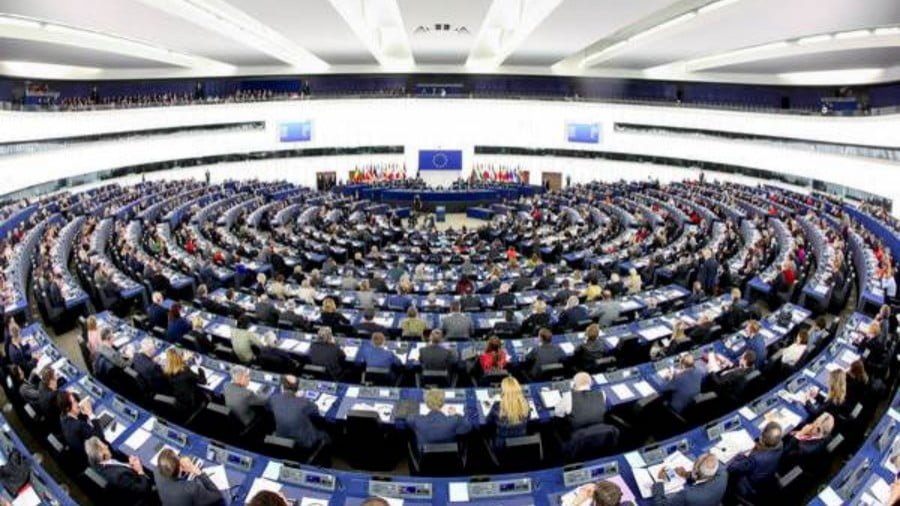Azov Sea Resolution Adopted: European Parliament Takes Another Swipe at Russia
The European Parliament (EP) has adopted a resolution calling for tougher sanctions from the European Union (EU) against Russia, should the situation in the Azov Sea continue to deteriorate. The document states that the Kerch bridge was built illegally, therefore the EP welcomes the council’s decision to impose restrictive measures against the companies involved in its construction. It suggests the creation of the position of special envoy on Crimea and the Donbass region in order to monitor the development of events there. And it warns about wider security implications that directly affect the EU. It demands that Russia “immediately end the intensive and discriminatory inspections of vessels and to consider, if necessary, appropriate countermeasures.”
Previously, Adm. Igor Voronchenko, the commander of the Ukrainian navy, threatened to use force against Russia as his service brought more ships to the area. Ukraine’s government announced last month that it would build a naval base there.
The EU has condemned Russia for launching a new inspection regime for cargo vessels coming from or heading toward Ukrainian ports in the Azov Sea. It is also accused of militarizing the sea by increasing the number of its ships deployed there.
On Oct. 3, NATO Secretary General Jens Stoltenberg expressed concern over the situation in the Azov Sea at a press conference in Brussels. Last month, US State Department Special Representative for Ukraine Kurt Volker stated that Washington is uneasy about the situation developing in the Sea of Azov, and is thus prepared to continue supplying Ukraine with weapons.
NATO and Ukraine held a major NATO operation Oct.10-19, dubbed Clear Sky, with substantial US Air Force participation. Just a few days ago, it was reported that the US government was considering the transfer of Oliver Hazard Perry-type frigates to Ukraine. This move will really boost that country’s sea power. Ukraine has only one seagoing warship — the frigate Hetman Sahaidachnyi. Since it is almost constantly out for repairs, it goes to sea rarely and only for very short deployments, such as NATO drills, never moving far from its home waters.
The delivery of relatively contemporary frigates with sophisticated weapons systems and equipment is a huge leap forward for the Ukrainian navy. The vessels are too large for the Azov Sea but they could operate around the entrance to it. Of course, the ships will be a factor to reckon with in the Black Sea. Ten ships of that class are available for export. They can be transferred under the Defense Department’s Excess Defense Articles program, which allows the release of surplus weaponry to friendly nations. In September, the US Coast Guard transferred two Island-class cutters, armed with .50-caliber machine guns and 25mm deck guns. The US is taking one step after another to push Kiev toward confrontation. Just as the election campaign in Ukraine is swinging into full gear, Kiev is being urged to challenge Russia militarily.
NATO naval operations are restricted by the 1936 Montreux Convention. Black Sea members don’t have many surface ships, and non-Black Sea allies are to rotate their ships every 21 days. This is a problem that can be solved with a little sleight of hand, such as by reflagging warships so that they fly Ukraine’s ensign. That’s how the American Oliver H. Perry frigates could be based in the Black Sea permanently. Any international agreement has a loophole. Russian military experts are old hands at this. They know perfectly well that the frigates will operate under US control.
That’s not all. Another way to skirt the provisions of the Monteux Convention is to sign a port concession agreement with a Black Sea country. This will trigger legal procedures based in the law of the sea, giving the US the opportunity to have some clauses reviewed regarding its naval operations. Ukraine comes in handy. The US military has its eye on the Ukrainian seaports of Odessa, Ilyichevsk, Chernomorsk, and Yuzhny. It already uses the Ochakov facility in Ukraine. Now that the construction work is over, US ships could drop anchor there. The convention does not allow aircraft carriers to enter the Black Sea, but Ukraine could be transformed into an unsinkable flattop.
The EU resolution sounds really tough. Why such a strong reaction and why now? Because Russian Foreign Minister Sergey Lavrov frustrated NATO’s plans to hold a provocative military exercise in the Azov Sea. Because of a bilateral treaty signed by Kiev and Moscow, Ukraine won’t be able to host the planned training event in the Sea of Azov without Russia’s consent.
Ukraine’s government is whipping up tensions because President Petro Poroshenko is running for reelection in March 2019 on a national security platform. This is pushing him to take a tougher line on Azov. In late March, Ukrainian border guards stopped the Russian-flagged, Crimean-registered fishing vessel Nord and illegally detained its crew. Ukraine was violating a number of international agreements. The incident triggered a campaign of provocative actions. In August, the Russian tanker Mekhanik Pogodin was detained in the Ukrainian port of Kherson. At the time, the Russian government compared that move to the activities of the Somali pirates.
The Russian government fully complies with its international commitments. The 2003 “Agreement between the Russian Federation and Ukraine on cooperation in the use of the Sea of Azov and the Strait of Kerch” does not specify a precise border. It states that the parties enjoy free use of this body of water and agree that the Sea of Azov and the Strait of Kerch are the internal waters of both Ukraine and Russia. No line of demarcation has even been drawn. Kiev believes it has the right to detain any ship traveling to or from Crimea without its permission.
Whatever Russia does is done legally. If there is a problem, Russia and Ukraine can solve it through negotiations. But neither the EU nor NATO has the idea of acting as a mediator to promote that process on its agenda. They could easily press Kiev into talks with Moscow but have not. Instead the EU votes for this provocative resolution, NATO expresses its political support, and the US sends warships and weapons. They are doing everything to goad Kiev into taking a confrontational approach and turning the Azov Sea into a flashpoint with a showdown expected at any minute.







